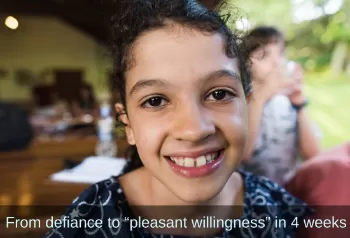Primitive Reflex Integration Case Studies
Defiance Greatly Reduced in 8-Year-Old with Anxiety and Sensory Issues
Tools from the Brain and Sensory Foundations program help improve behavior and social-emotional skills.
Over the course of 4 weeks, this OT and parent used rhythmic movements and Moro reflex integration to help her daughter significantly decrease defiance, hitting and kicking, and meltdowns.
Submitted by Mary, Occupational Therapist

| Before | After |
|---|---|
| Defiant in response to parent directions, average of 3+ times per day outside of school hours. | Significantly decreased to 1-2 times per week, mostly when N was very tired or overstimulated. She also increased dramatically with overall pleasant willingness to complete chores or other household tasks. |
| Hitting/ kicking/ pushing mother and older siblings, average of 3+ times per week. | No episodes of hitting or kicking occurred following initiation of integration activities. |
| Meltdowns after school or other settings with multiple people, frequently complains that it was too loud. | 0-1 time per week following integration as described. |
| Nightly disruption with falling asleep, takes 30 minutes or longer after lights are out. | Usually falling asleep within 5-10 minutes of lights-out time. |
N is our 8 year old daughter who is a highly intelligent, deeply feeling child who also struggles with mild anxiety and emotional regulation, particularly in the home setting where she feels the most comfortable. This results in intense verbally reactive outbursts (i.e. angrily yelling “I’m NOT going to do that!”) as well as behavioral challenges such as occasionally hitting/ kicking. She is auditorily sensitive and can be overwhelmed by louder, more chaotic settings including the school classroom at times, resulting in meltdowns after school. She also experiences nearly nightly disruption with falling asleep.
Goals include increased compliance with parent directions, decreased physical outbursts, decreased auditory sensitivity as measured by fewer after school meltdowns due to “too loud” situations, and improved ability to fall asleep in a timely fashion.
Tools: I chose to use Rhythmic Movements [from the Brain and Sensory Foundations First Level course] as well as integration of the Moro reflex. N demonstrated mild but noticeable indicators of active Moro when stimulated for Moro, but no indicators for other reflexes. In addition, she demonstrates multiple symptoms of a possible retained Moro as described in client’s challenges. Total length of time working with client on these activities: 5-10 minutes per day, usually in the evening, for 5 days per week, 4 consecutive weeks.
Incorporated 5-step balance process to address cleaning her room, which is a chore that she frequently becomes reactive about and fights against completing. Goal statement: I clean my room calmly and easily. We acted out the goal by miming picking up items in her room and putting them “away”. Movements used for the integration step were Moro reflex related, including crouching into a ball then standing up in full extension because of the fight/flight reactivity she experiences when reminded to clean her room. Results included improved receptivity to the direction to clean her room, and improved focus on the task.
As a result of completing these activities [from the Brain and Sensory Foundations course] with my daughter, her ability to adjust to changes in routine improved significantly overall. Her behaviors surrounding compliance improved and involved significantly less yelling or refusal, while the more physical symptoms such as physical aggression decreased. In addition, sleep issues also improved.
[Edited for length and clarity; emphasis added]
*Disclaimer: The activities in the Brain and Sensory Foundations curriculum make use of the natural processes of neuroplasticity and development that are innately wired in the design of human beings to promote maturity and function. These activities appear to calm, organize, and mature the neuro-sensory-motor systems just as we see in the healthy development of human infants. Individual results may vary, and we do not claim to offer a diagnosis or cure for any specific condition or disorder. The Brain and Sensory Foundations activities appear to improve overall functioning resulting in measurable improvements for a range of conditions as demonstrated in over 1800 case studies from participants.

